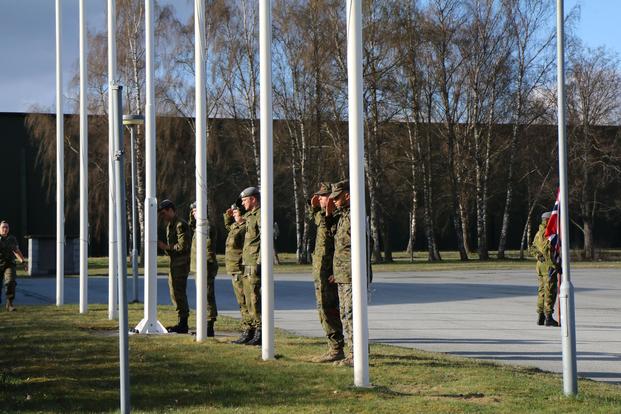VAERNES GARRISON, Norway -- Only months into what will be a year-long trial period for rotating Marine Corps elements through this sleepy base in central Norway, Marine leaders are eager to expand the partnership, eyeing a plan to more than double the service's presence here.
About 285 Marines from Camp Lejeune, North Carolina, arrived in Norway in mid-January, the first iteration of what is now called Marine Rotational Force-Europe. The objective, both Marine Corps and Norwegian officials say, is to improve the American troops' ability to fight in the Arctic cold, and to strengthen partnerships with NATO allies, both in Norway and elsewhere in the region, with collaborative training and exercises.
The Corps currently has another standing training deployment, the 400-Marine Black Sea Rotational Force, based 2,000 miles away from Vaernes at Mihail Kogălniceanu, Romania. But pending Norwegian approval, that may soon change, according to Maj. Gen. Niel Nelson, commander of Marine Corps Forces Europe and Africa.
"Our current allocated force in Europe is sat at about 650 Marines, and that allocated force could be postured here," Nelson told Military.com in an interview here.
While the Marine Corps also has a crisis response force for Africa positioned at Moron Air Base in Spain, that unit falls under U.S. Africa Command and is subject to separate considerations.
In addition to proximity to the cold-weather battle training that Commandant Gen. Robert Neller has said he wants to emphasize, Vaernes offers the Marine Corps next-door access to a series of caves, maintained by the Norwegian military, that stock enough gear, vehicles and ammunition to equip a force of more than 4,600 troops. Managers of the system, called Marine Corps Prepositioning Program-Norway, said use of the gear for training and exercises on the continent had grown "exponentially" in the last 24 months.
In that time, decreased ground operations in Afghanistan and rising tensions in Russia have caused the Marine Corps and Army to focus attention more strategically on Europe, with the Marines expanding joint training opportunities wherever possible.
"Now that we, the Marine Corps, are able to shift focus out of the desert a little bit more, and get back to being able to fight in any clime and place, Norway is getting a lot of focus," said Maj. Tom Stona, prepositioning officer for Headquarters Marine Corps. "So [Marine Forces Europe] is doing a lot of exercises up here, and MCPPN managers are happy to facilitate that with equipment."
"An evaluation of the limited rotational presence is ongoing, and the United States has not made a final decision on requesting an extended presence," Air Force Lt. Col. David Faggard, a spokesman for U.S. European Command, said in a statement. "We must let the evaluation-process run its due course without speculating on an outcome on the future U.S. Marine rotational presence in Norway."
In addition to potentially becoming the Corps' hub in Europe, Vaernes could become the site of much smaller, more temporary training elements cycling through the region, Nelson said.
"We could bring Marines out here in various capability sets, from airplanes, to ground maneuver, to logistics, to communications, to cyber," he said. "[They] can come out here and practice their skills with a partner of choice, and we would help coordinate that and lead that. They would come for two, three weeks, and learn and go back. That's a ready, capable force for the United States."
All these decisions lie with the Norwegian Parliament, which late last year approved a one-year trial period for the Marine presence, including two six-month rotations. Other negotiations could involve Romania, which has hosted Black Sea Rotational Force Marines since 2010.
Nelson said he believes the parliament will make a decision before the end of this year on the future of the Corps' presence and whether to host more Marines. Troops with Marine Rotational Forces-Europe now live in Norwegian-built barracks at Vaernes and eat in the base's chow hall, sharing the space with about 650 troops from Norway's Home Guard District 12.
"[The parliament] will make a decision on whether or not they believe our limited presence here is value added to them," he said. "I think they'll lean that way."
The commanding officer of District 12, Col. Haakon Waroe, declined to address the possibility of an expanded Marine presence in Norway, saying it remains a political question.
"I would like to see us being able to continue what we have already established," he told Military.com. "The local cooperation is going very well."
-- Hope Hodge Seck can be reached at hope.seck@military.com. Follow her on Twitter at@HopeSeck.































